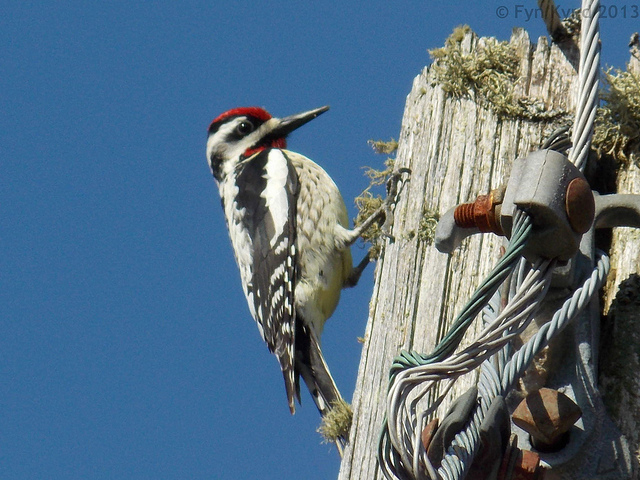Like this article? rabble is reader-supported journalism. Chip in to keep stories like these coming.
First came the string of window strikes at a commercial highrise. Then, a flock of bohemian waxwings ploughed into a glass bridge at city Hall. Now, a flock of snow buntings has met its grisly end at the airport, struck by an airbus.
It’s tough, being a bird in Ottawa. But it’s no different at many other major cities across the country. And, it’s only going to get worse.
The spring migration is well underway in Canada, bringing hundreds of thousands of migratory birds, from warblers to waxwings, back to their summer nesting grounds. Along they way, they’ll pass through the country’s biggest cities — and many of them will stay there as feathery heaps on the pavement.
Surprisingly, the problem isn’t the air pollution, or the encroachment on greenspace — not directly, though they’re certainly factors. The issue boils down to a substance we see every day: glass.
Our cities are full of it. And as a result, Carolyn Callaghan, a senior conservation biologist at the Canadian Wildlife Federation, says approximately 25,000 window strikes occur each year.
“The bulk of the collisions would occur in our biggest cities,” she says. “Toronto is particularly high in number because it is on a convergence of two major flyways.”
The bulk of the casualties are the birds we identify with most. Songbirds of all shapes and sizes, from buntings to kingfishers to sapsuckers, are dropping like flies.
But in some cities, there is a growing movement to address the issue. Callaghan says Toronto is a Canadian leader in addressing window strikes. The city requires new commercial buildings to install windows with reduced reflection, to curb strikes during the day.
Change is afoot at the national level, too. The Building Owners and Managers Association of Canada implemented bird impact strategies in 2012 as part of its BOMA BEST program, which has 2000 certifications. The guidelines encourage bird-friendly design and operations, including the installation of bird-proofed glass.
“In general, I find the industry to be very responsive to this issue,” says Benjamin Shinewald, the organization’s President and CEO. “In my four years, no one has ever been critical of the BOMA initiatives and I have received some very strong positive reinforcement for the efforts.”
It’s a significant gain for bird advocates, but even with a range of bird-friendly glass treatments on the market, there’s still a ways to go. Shinewald says the bird guidelines aren’t mandatory, and the association doesn’t track how many members have adopted them.
The problem isn’t limited to glass, either.
Night migrators usually navigate by the stars, using them to find their way as they cross thousands of kilometers of darkened landscape. As they pass over cities, many will flock to lit windows like moths to a flame. “When there’s a highly lit up area that they’re flying through they can get confused, and they end up flying around and around the building, and then they end up dropping from exhaustion.”
The Canadian Wildlife Federation introduced Bird Impact Reduction Day (BIRD) as a means of raising awareness, asking commercial business owners to turn out the lights on April 12. BOMA’s bird guidelines also ask members to turn off their lights at night. But with the growth of Canada’s cities, Callaghan says it’s going to take a concerted effort from both residents and business owners to really tackle the problem.
“It is getting worse because our cities are getting bigger,” she says. “The birds don’t change their flyway because they’ve existed for millennia, so they do what they’ve always done. But the problem is getting worse.”
You would think, with a significant number of their members dying each migration, that birds would learn to avoid major cities.
However, Callaghan says the problem is more complicated than that. Evolution is a difficult process to fast-track, and collective memory dies hard.
“Unfortunately, there just haven’t been windows and buildings long enough, evolutionarily speaking, for birds to figure this out,” she says. “They’ve only been around for a few hundred years, while birds have been around for thousands.”
Skyscrapers and large commercial buildings aren’t the only ones to blame, either. Residential homes account for a significant portion of bird strikes, which typically occur within 20 metres of the ground.
“What’s interesting to me about this issue is that we can make a difference at a very basic level,” says Callaghan. “It doesn’t require decisions made at a very high level of government.”
She recommends turning out the lights at night and moving bird feeders and potted plants away from windows to reduce the risk of collisions. At the end of the day, she’s optimistic that Canada will see more action on the issue.
“We all love to see the birds, we love to hear the birds, in the springtime we welcome the birds back to Canada,” she says. “So I think we have birds in our hearts, and I think that’s why it’s an important issue that people want to learn about.”

Jen Halsall is studying journalism and history at Carleton University in Ottawa. She is a passionate environmentalist with a penchant for science reporting and a soft spot for “all that is green and good.” You can find her on twitter as @Jennhalsall. She is rabble’s 2015-16 blogs intern.
Like this article? rabble is reader-supported journalism. Chip in to keep stories like these coming.




